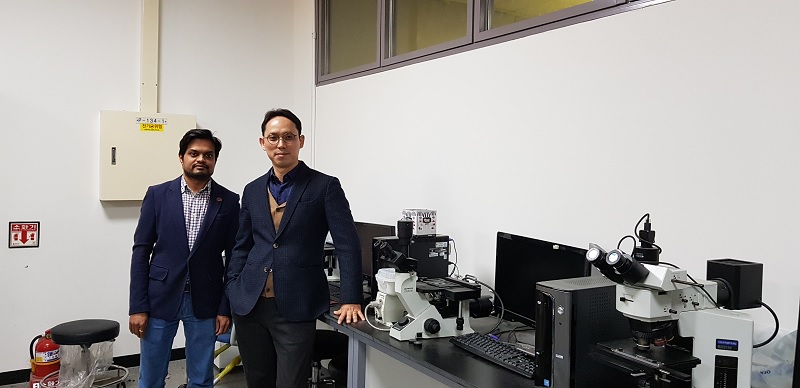서형탁 교수팀, 수소 생성 고효율 태양광촉매 전극 개발
우리 학교 서형탁(신소재공학과·대학원 에너지시스템학과) 교수 연구팀이 고효율 태양광촉매 전극을 개발했다. 태양광으로 물을 분해하여 수소를 얻는 광 전극의 효율성과 내구성을 높이고 제작 비용을 획기적으로 낮추게 될 전망이다. 서형탁 교수 연구팀이 개발한 물질의 정식 명칭은 ‘구리-바나디움 나노 결정 산화물 기반의 고효율 태양광촉매 전극’이다. 공동연구원으로는 우리 학교 샨카라 칼라누르 교수(Shankara S. Kalanur, 신소재공학과)가 참여했다. 이번 개발은 태양광 에너지 분야에서 주목받는 소재인 구리를 활용했다는데 의의가 있다. 구리산화물은 태양광을 효율적으로 흡수하고 지표면상에서 쉽게 구할 수 있는 금속이기 때문에 가격 경쟁력이 있지만, 실제 태양광 흡수 이후 형성되는 전하이동효율이 떨어져 최종 효율이 낮아지는 한계가 있었다. 서 교수 연구팀은 광 전극이 용액합성으로 구리 원소를 바나디움 원소와 나노구조형상의 합금화를 통해 개발했고, 이로써 최적의 태양광 ‘입사광자변환효율’ 입사광자변환효율: 태양광에너지가 물 분해 반응 전류로 전환되는 양자 효율을 얻었다. 이 과정에서 합금 조성을 정밀하게 제어하는 기술이 사용됐다. 서형탁 교수는 "세 가지 다른 조성으로 개발된 나노 합금은 비록 같은 원소 구성 성분의 합금이더라도 각 원소의 조성비에 따라 태양광을 흡수하는 광학적 특성과 전하분리에 관여하는 전자구조에는 큰 차이를 보임을 전자구조 분석을 통해 규명했다"며 "이것이 태양광변환효율에 영향을 미치는 핵심 인자"라고 설명했다. 서 교수 연구팀은 정밀 조성 및 전자구조 제어를 통해 광 변환 효율을 합금 간 최대 200% 이상 개선시켰고, 본 구리기반 산화물 합금 결과에서는 기존 연구의 3% 수준과 비교해 6배 가량 개선된 약 18%의 양자효율을 얻었다. 서형탁 교수는 “저가·비 희귀 금속인 구리 복합 산화물을 기반으로 고효율 나노구조 광 전극을 얻는 정밀 합성법과 전자 구조 분석법을 개발한 것이 이번 연구의 주요 성과"라고 말했다. 한편, 이번 연구결과는 화학촉매 분야 저명 국제학술지인 ‘어플라이드 카탈리시스 B: 인바이런멘탈’ (Applied Catalysis B: Environmental, 논문인용지수(IF)=11.698, JCR 저널랭킹 상위 1%) 2월 26일자 온라인 판에 소개됐다.
A research team led by Professor Seo Hyung-Tak (Department of Materials Science and Engineering, Graduate School of Energy System) of our school developed High Efficiency Solar Photocatalyst Electrode. The efficiency and durability of photoelectrode, which obtains hydrogen by decomposing water by sunlight, is expected to be improved and manufacturing costs will be drastically lowered.
The name of the material developed by Seo Hyung-taks team is High efficiency solar photocatalyst electrode based on copper-vanadium nanocrystalline oxide. Shankara S. Kalanur, Department of Materials Science and Engineering, participated as co-researcher (1st author) in our joint research.
It is meaningful that this development utilized copper which is a material attracted attention in the solar energy field. Copper oxide is cost competitive because it absorbs sunlight efficiently and can be easily obtained on the earths surface. However, there is a limitation in that the final efficiency is lowered due to the charge transfer efficiency formed after actual solar absorption. Professor Seo Hyung-tak said, "Although the nano-alloys developed with three different compositions have different optical characteristics, which depend on the composition ratio of each element, and the electronic structure involved in charge separation, "It is a key factor that affects solar conversion efficiency," he said. Professor Seos team improved the optical conversion efficiency by more than 200% between the alloys by precise composition and electronic structure control. The result of this copper-based oxide alloy showed that about 18% Efficiency was obtained. Professor Seo Hyung-taek said, "This is a major achievement of our research and development of precise synthesis method and electronic structure analysis method to obtain high-efficiency nano-structured photoelectrode based on low cost, rare metal copper complex oxide."
The results of this study are as follows: Applied Catalysis B: Environmental (IF) = 11.698, top 1% in the JCR Journal ranking. Feb 26 It was introduced in the online edition
<뉴스 바로가기>
|